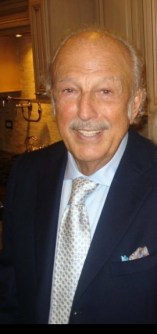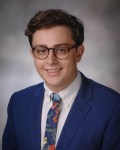Like Fenwick, the storied downtown restaurant has stood the test of time for nine decades — and for three family generations.
By Patrick Feldmeier ’20

The impact that the late Franklin Delano Capitanini, Class of 1950, left on Chicago cannot be justly put into words. Instead, his impact resonates in his family, friends, Fenwick High School and the famed Italian Village Restaurant(s). Born in America in 1932 and named after U.S. President Franklin D. Roosevelt, Frank lived a life founded on strong family ties and treated everyone who dined at the Italian Village as if they were old friends. Today, the Italian Village serves as a reminder of the kindness that Mr. Capitanini spread for 85 years.
Located at 71 W. Monroe Street in Chicago’s “Loop” for almost 92 years, the Italian Village was opened by Frank’s father, Alfredo, in September 1927 – two years before Fenwick opened its doors. Frank and his kid brother, Ray (Fenwick ’53), grew up knowing that the restaurant someday would be theirs to manage. Frank’s early years working there included responsibilities such as food preparation for the chefs and waiting tables, according to his close friend, Fenwick classmate and President Emeritus Father Richard LaPata, O.P. ’50. Learning how to talk to adults and serve their requests at an early age benefitted Frank greatly in the years to come. Frank’s son and fellow Friar alumnus, Al Capitanini ’81, says that the “best internship is waiting tables because you learn about customer service and how to handle people.”

Franklin’s 1950 yearbook portrait from Fenwick.
Frank continued his work at the Italian Village when he attended Fenwick, where he participated in football, basketball and track. Unfortunately, his athletic career was cut short due to an injury. Al remembers hearing how his father had to divert all of his attention to education after the injury because Frank’s parents highly valued education. Frank’s father, an Italian immigrant, wanted him to have a strong caring for education due to his own limited schooling opportunities in Italy. When Frank was not hitting the books, he left his friends drooling in the school cafeteria because of the sandwiches he brought daily from the Italian Village. The aroma of Italian lunch meats and cheeses made their palates jealous.
Frank and Fr. LaPata both went on to Notre Dame, but their paths did not cross much at the university: one entered the seminary while the other (Frank) was in the ROTC program. It was not until Father LaPata became president of Fenwick in 1998 that he developed a friendship with Frank, eating at the Capitanini home around once a month.
A Culinary Institution
Once out of college, Frank immediately went back to work at the Italian Village. In the 1950s and ’60s, opera drew huge crowds in big cities like Chicago, so the Capitaninis became well acquainted with some the world’s most famous opera singers. When asked about the relationship between it and the Italian Village, the Lyric Opera Company kindly stated, “American singers and Italian singers of the 1950s and 1960s dined at the Italian Village.” However, opera stars were not the only celebrities to frequent the restaurant. The walls of the Italian Village are lined with autographed pictures from well-known celebrities and sports figures, including Frank Sinatra, Lou Holtz, Mike Ditka, Florence Henderson, Ryne Sandberg and Jon Bon Jovi.

The Village, the upstairs restaurant, features dimmed lights that hang low and walls painted to mimic a scenic view in Italy.
The Italian Village has maintained its reputation of great service and hospitality because of Frank’s leadership and family values: “Hundreds [of restaurants] closed, but the Italian Village stayed strong due to its hospitality, charm and kindness,” praises Father LaPata. With an old-fashioned aura and breathtaking architecture, the Village has stood the test of time by adhering to its roots; something that many restaurants in Chicago have failed to do. Upon entering one of the three restaurants in the Italian Village, patrons are engulfed in a one-of-a-kind atmosphere. The Village, the upstairs restaurant, features dimmed lights that hang low and walls painted to mimic a scenic view in Italy. No windows are present, and it truly feels as if you are dining in Italy.

Later in Frank’s life, he began to teach his kids how to manage the family restaurant. Fortunately, his four children, Lisa, Gina, Frank II ’78 and Al, had hands-on involvement for years. Al vividly remembers growing up at the Village: waiting tables and making food just like Frank did years ago. “We ate more than we actually learned,” he admits. Gina still works in the family business.
When the kids were a bit older, Frank would take them to the restaurant for breakfast, then walk with them to catch a Bears game. Al describes his father as an “old-school type, hardworking, honest to a fault, always there, and would help anyone in an emergency.” Frank served as a great mentor to Al and his other children, and they work hard to emulate their dad. His philanthropic contributions to Fenwick are greatly appreciated as well.
Visiting the Village
I had the pleasure of having lunch with Al this spring at the Italian Village. We talked about the history of the restaurants and Frank’s long-lasting impact on them. When the topic of Frank’s years in high school arose, Al was quick to mention that Fenwick was essential in molding Frank into the man he wanted to be. Frank may have had a career already set through the Italian Village, however, his success and achievements in life required the lessons learned from Fenwick to come to fruition. Through the stories Al shared about Frank’s life at Fenwick as well as his own, I was truly able to understand that Fenwick is great at preparing its students for life ahead.
Frank passed away one year ago at age 85. His funeral was held at his grade school, St. Vincent Ferrer in River Forest, and Father LaPata touchingly led the Mass. His presence will be missed, yet his spirit will live on in the lives of those around him. Frank Capitanini will forever be a Friar, and his impact on his family, the Italian Village and Fenwick High School will last for generations to come.
Coming soon: The Frank Capitanini Classroom at Fenwick

World Languages students in Fenwick’s “Italian Room” (Room 14), which is being renamed in honor of late alumnus/restaurateur Frank Capitanini ’50.
In addition to their generous classroom-naming donation, the Capitanini family also has created an endowed scholarship in their father’s memory. The fund will provide tuition assistance for a Fenwick student in need.

Read a Chicago Tribune article about Frank.
About the Author

Patrick Feldmeier is a finishing up his junior year at Fenwick High School, where he is an Honor Roll/National Honor Society student and president of the Class of 2020. Pat also plays on the Friars’ football and rugby teams. He lives in Western Springs, IL (St. John of the Cross) and is hoping for acceptance this coming fall into the University of Notre Dame, where his Evans Scholar brother, Danny ’18, will be a sophomore.







 Editor’s Note: 2018 Fenwick graduate Nick Bohlsen, of Oak Park, is finishing his freshman year at DePaul University in Chicago. Bohlsen wrote this paper last semester for his “Writing Rhetoric and Discourse 103” class, earning an “A” for his effort. (A Networking Infrastructure 263 course also used a more detailed version of this report.)
Editor’s Note: 2018 Fenwick graduate Nick Bohlsen, of Oak Park, is finishing his freshman year at DePaul University in Chicago. Bohlsen wrote this paper last semester for his “Writing Rhetoric and Discourse 103” class, earning an “A” for his effort. (A Networking Infrastructure 263 course also used a more detailed version of this report.)

 Internet ad delivery is a complex process involving multiple redirections, synchronizations of user information and an auction, all in a few tens of milliseconds. (Wicker & Karlsson, 70)
Internet ad delivery is a complex process involving multiple redirections, synchronizations of user information and an auction, all in a few tens of milliseconds. (Wicker & Karlsson, 70)


 “The idea is to develop a playlist for a main character, and I chose Sydney Carton from A Tale of Two Cities,” Magrady explains. The next day, she asked her English II College Prep students to do the same. The assignment took off running.
“The idea is to develop a playlist for a main character, and I chose Sydney Carton from A Tale of Two Cities,” Magrady explains. The next day, she asked her English II College Prep students to do the same. The assignment took off running.
 Throughout the course of 90 school years, Fenwick High School has seen its fair share of high-achieving scouts pass through its storied doors. Earning the Boy Scouts’ distinction of Eagle Scout or receiving the Girl Scouts’ Gold Award are akin to graduating as a Friar: They are highly significant accomplishments that, quite frankly,
Throughout the course of 90 school years, Fenwick High School has seen its fair share of high-achieving scouts pass through its storied doors. Earning the Boy Scouts’ distinction of Eagle Scout or receiving the Girl Scouts’ Gold Award are akin to graduating as a Friar: They are highly significant accomplishments that, quite frankly, 






 Gold Award recipients also have a competitive edge in the college admissions process and are eligible for
Gold Award recipients also have a competitive edge in the college admissions process and are eligible for 








 He is one of only 23 coaches to win a Super Bowl with more than one team: two back to back with the Denver Broncos (1997 and 1998) in the John Elway era and one with the Indianapolis Colts (2006) in the Peyton Manning era. (“Sorry, Bears fans,” jokes Teerlinck, whose family moved when he was eight years old from upstate New York to suburban LaGrange Park, IL.)
He is one of only 23 coaches to win a Super Bowl with more than one team: two back to back with the Denver Broncos (1997 and 1998) in the John Elway era and one with the Indianapolis Colts (2006) in the Peyton Manning era. (“Sorry, Bears fans,” jokes Teerlinck, whose family moved when he was eight years old from upstate New York to suburban LaGrange Park, IL.)

 When he played defensive line for Fenwick in the 1967 and ’68 seasons, the Fighting Friars’ varsity went a combined 10-5. After a 7-2 junior campaign, a 3-5 record as a senior was disappointing. The defensive unit gave up a respectable 15.5 points per game (ppg) in the autumn of 1968. However, an anemic offense could muster only nine touchdowns all year for a paltry average of 7.25 ppg. Teerlinck was an All-Conference selection and went on to become an All-American for the Western Illinois University (Macomb, IL) Leathernecks. “We used to get New York Giants games at Western and I’d watch No. 89, Fred Dryer, and copy his moves,” Teerlinck told Chicago Tribune writer Don Pierson in a
When he played defensive line for Fenwick in the 1967 and ’68 seasons, the Fighting Friars’ varsity went a combined 10-5. After a 7-2 junior campaign, a 3-5 record as a senior was disappointing. The defensive unit gave up a respectable 15.5 points per game (ppg) in the autumn of 1968. However, an anemic offense could muster only nine touchdowns all year for a paltry average of 7.25 ppg. Teerlinck was an All-Conference selection and went on to become an All-American for the Western Illinois University (Macomb, IL) Leathernecks. “We used to get New York Giants games at Western and I’d watch No. 89, Fred Dryer, and copy his moves,” Teerlinck told Chicago Tribune writer Don Pierson in a 







 VIDEO:
VIDEO: 















































